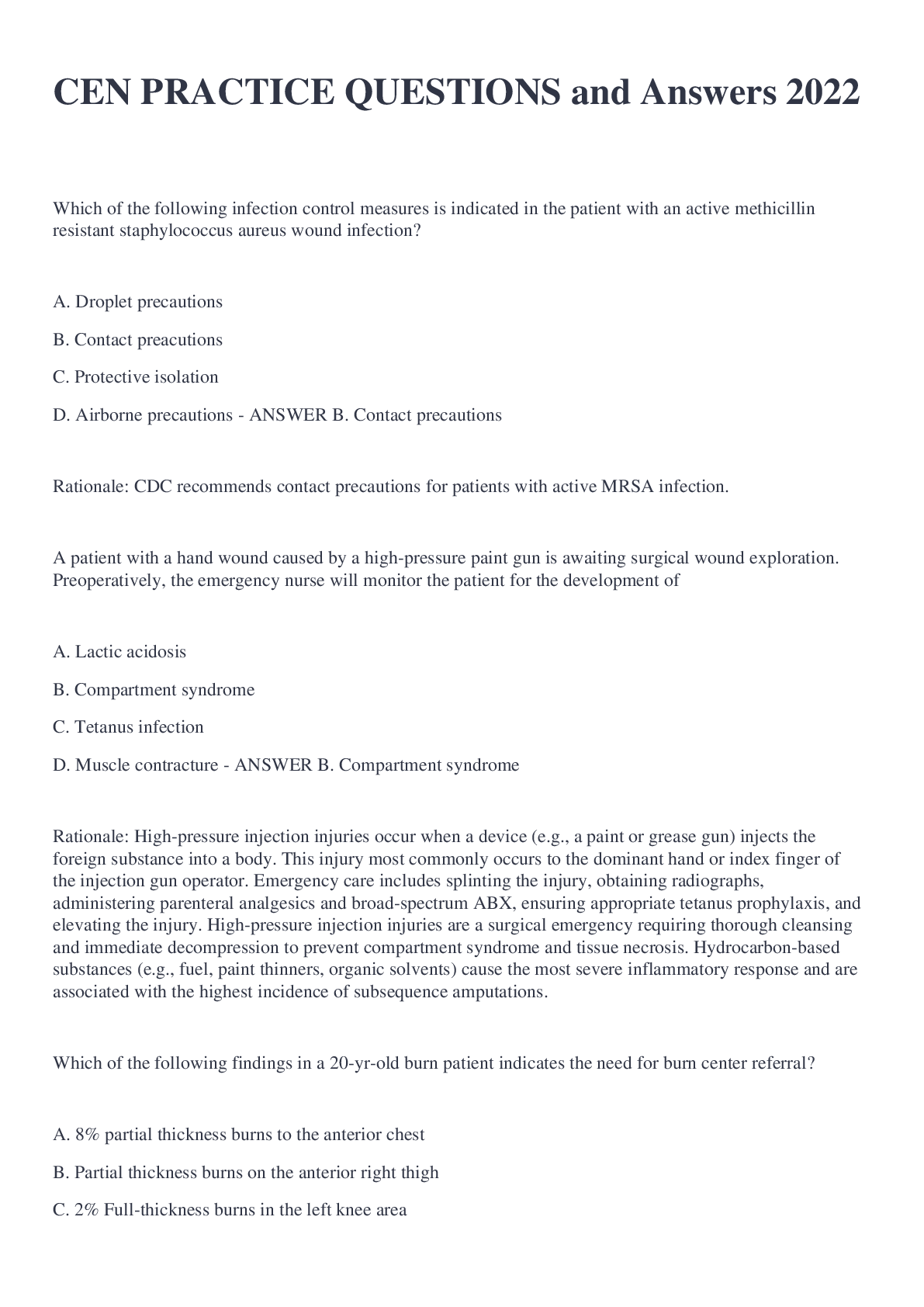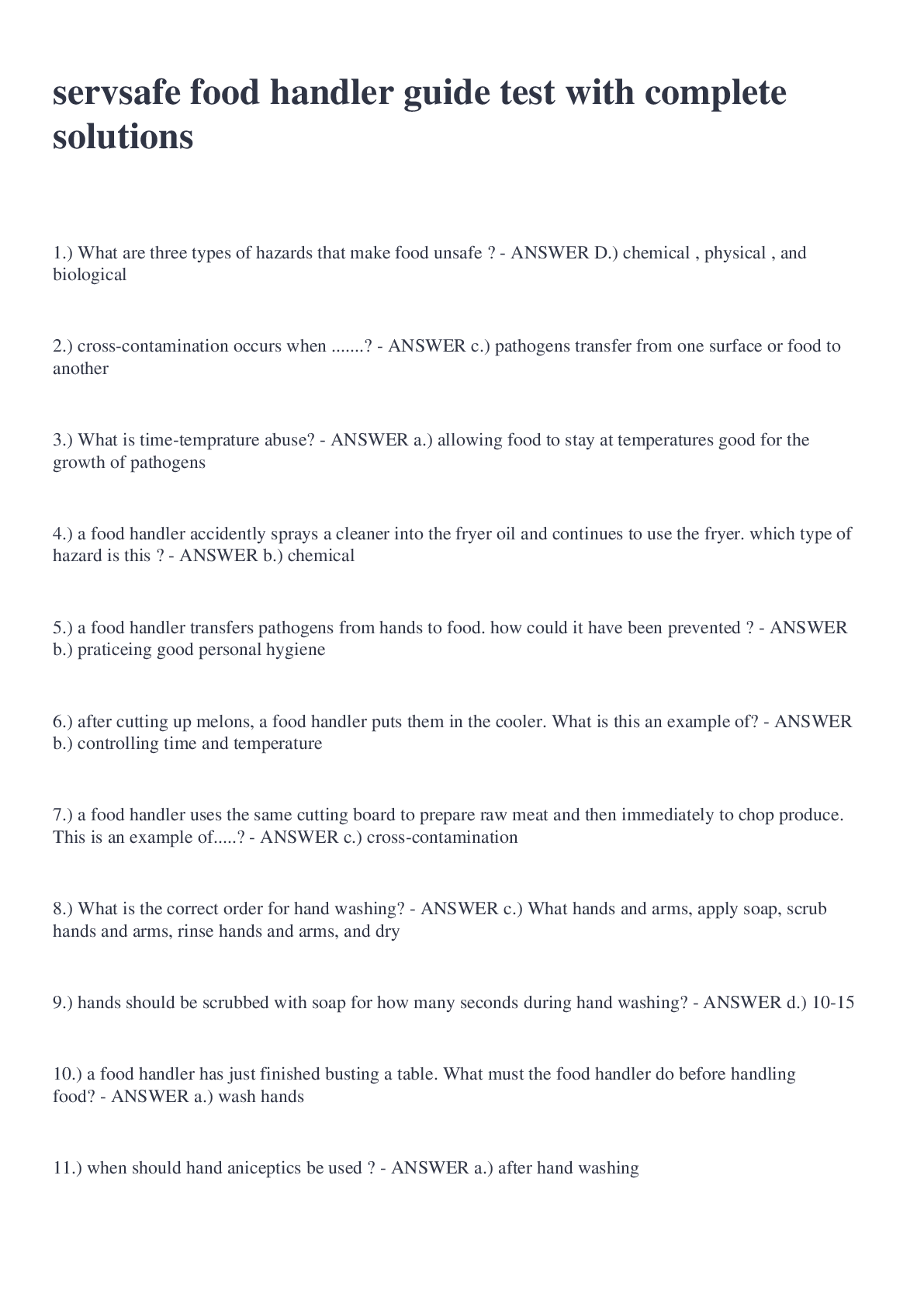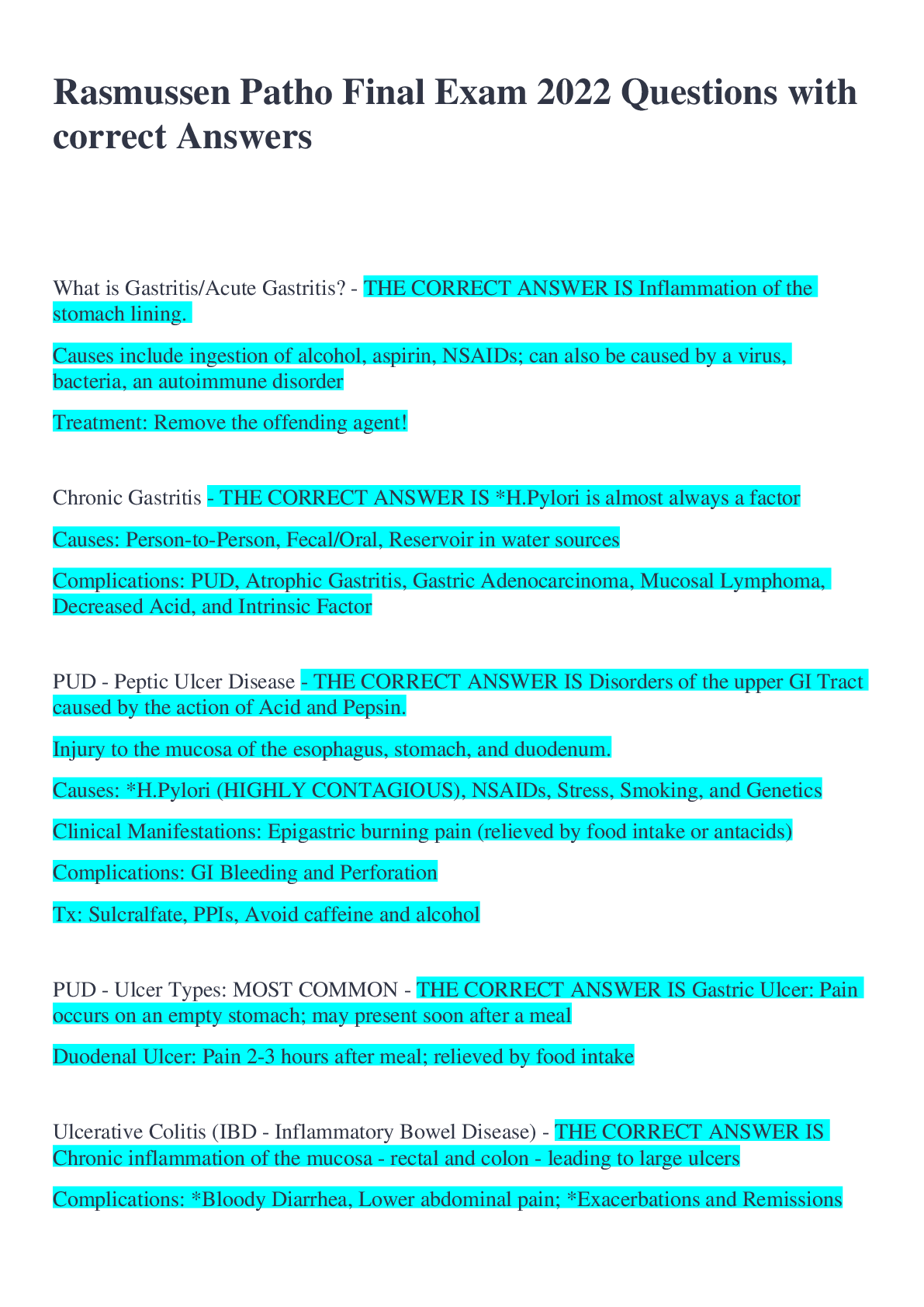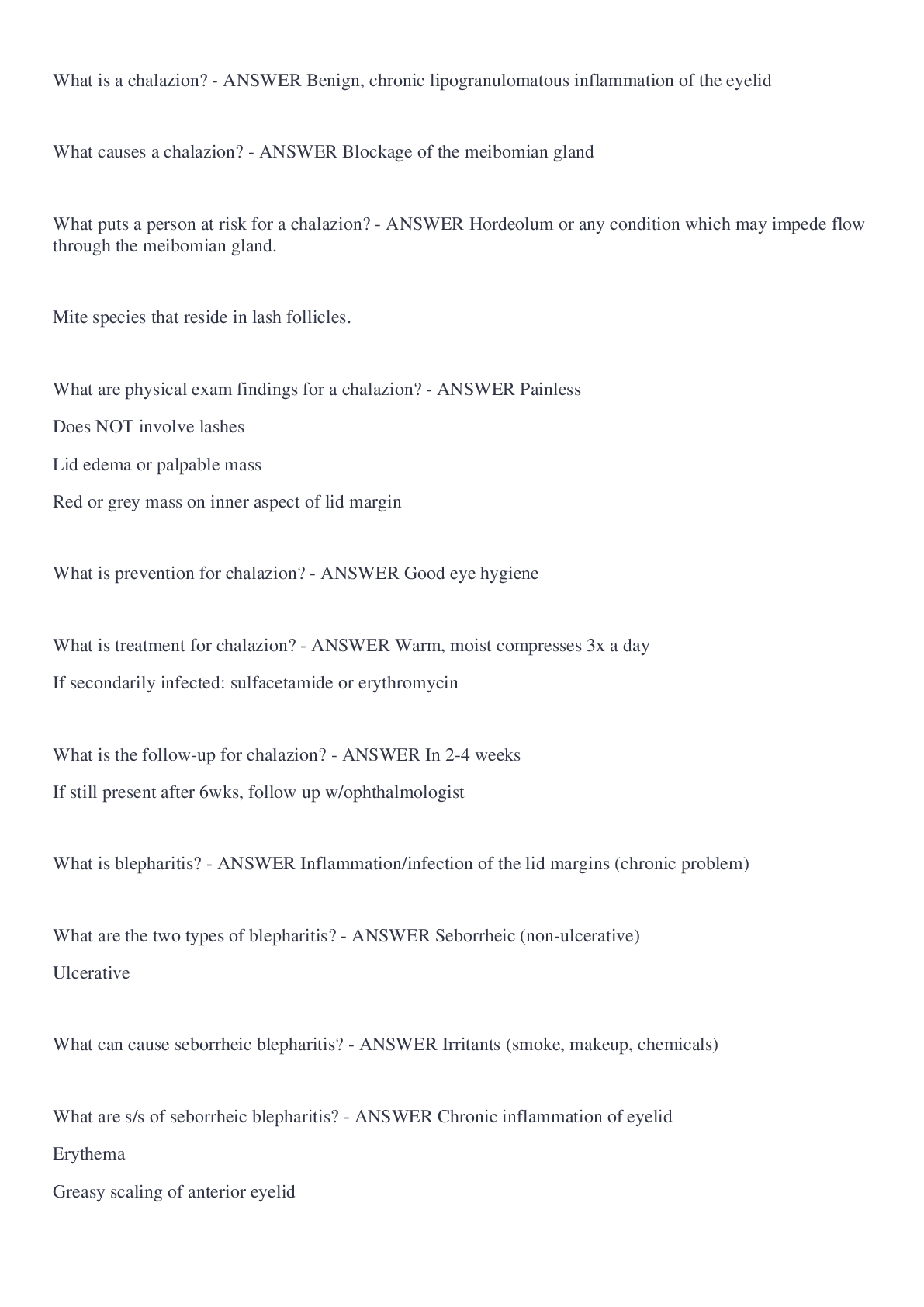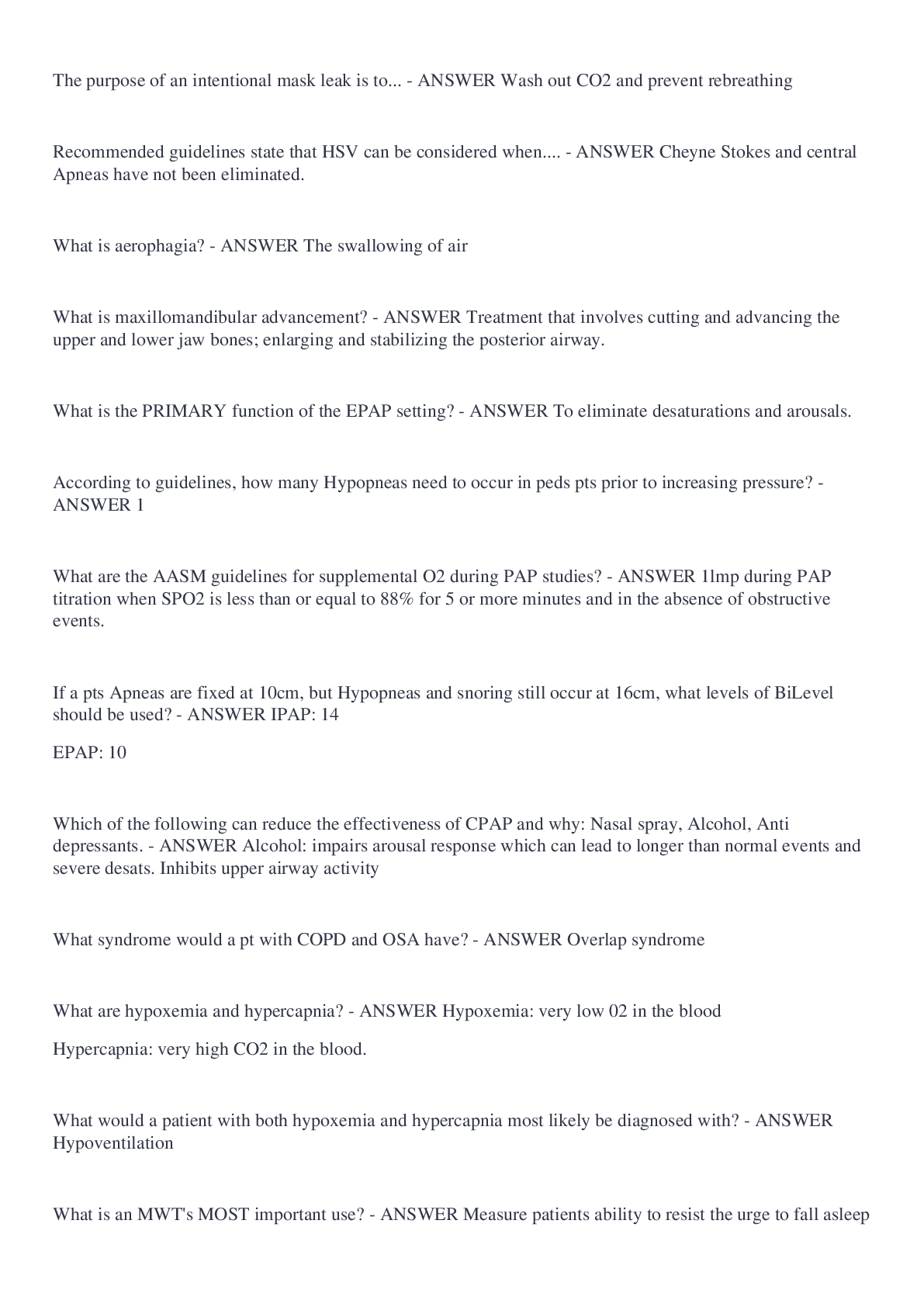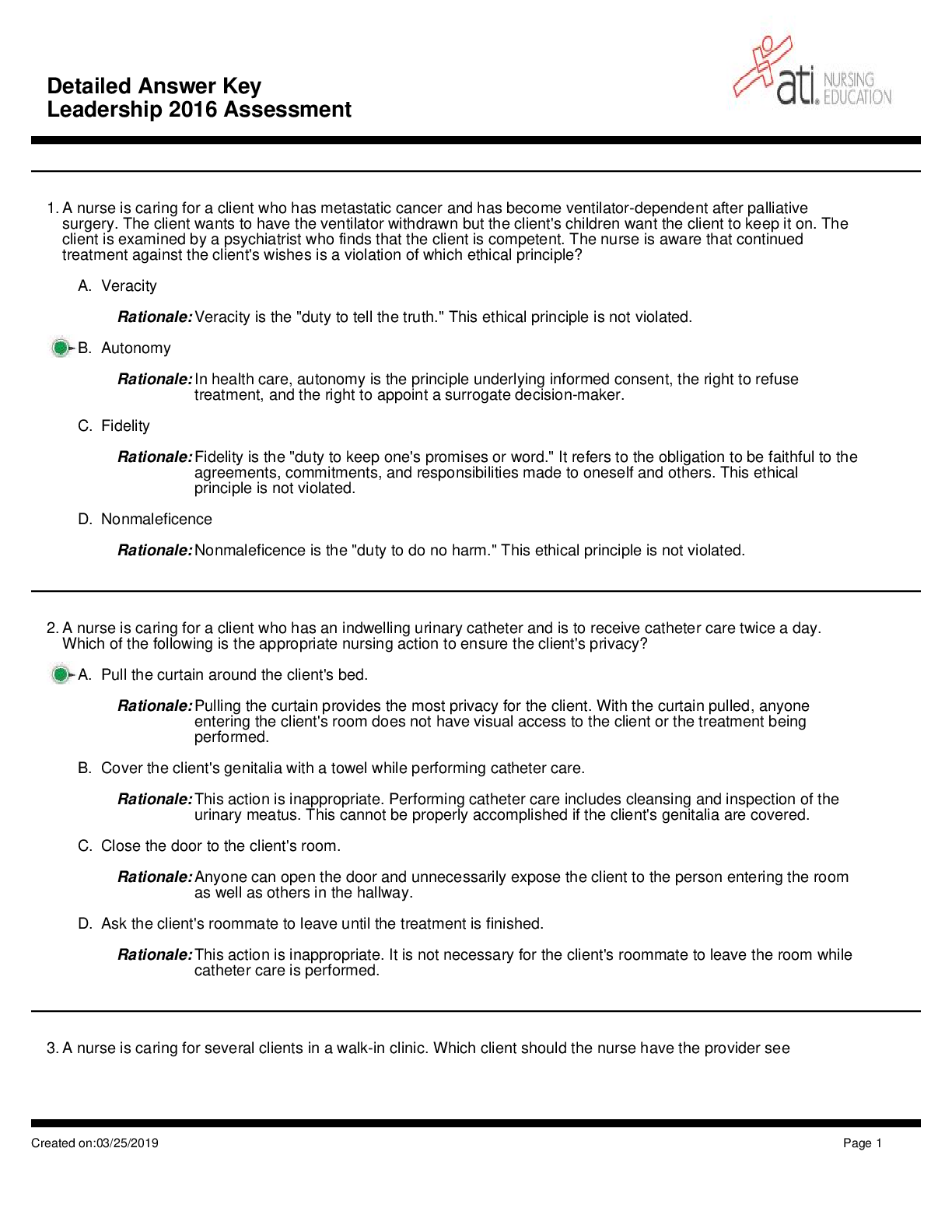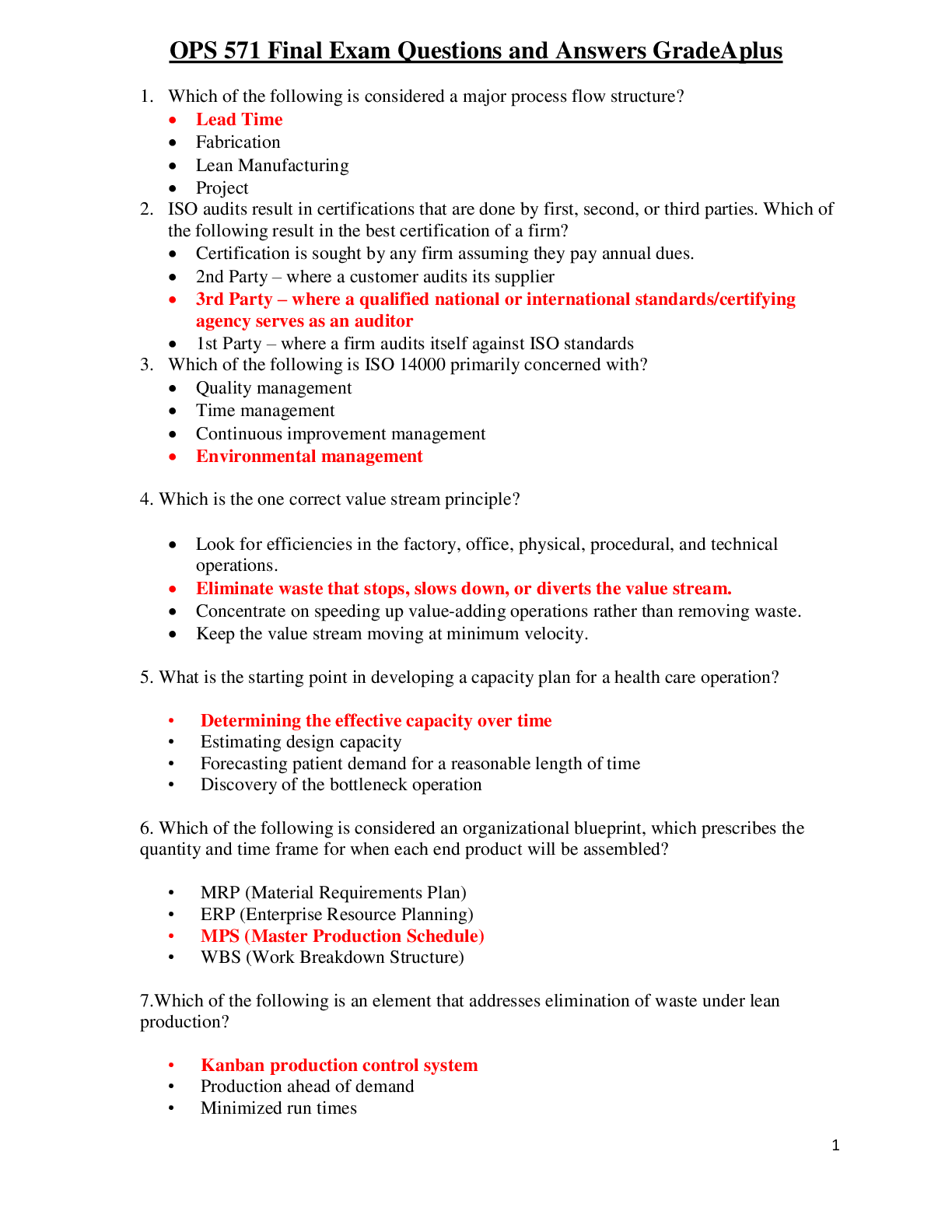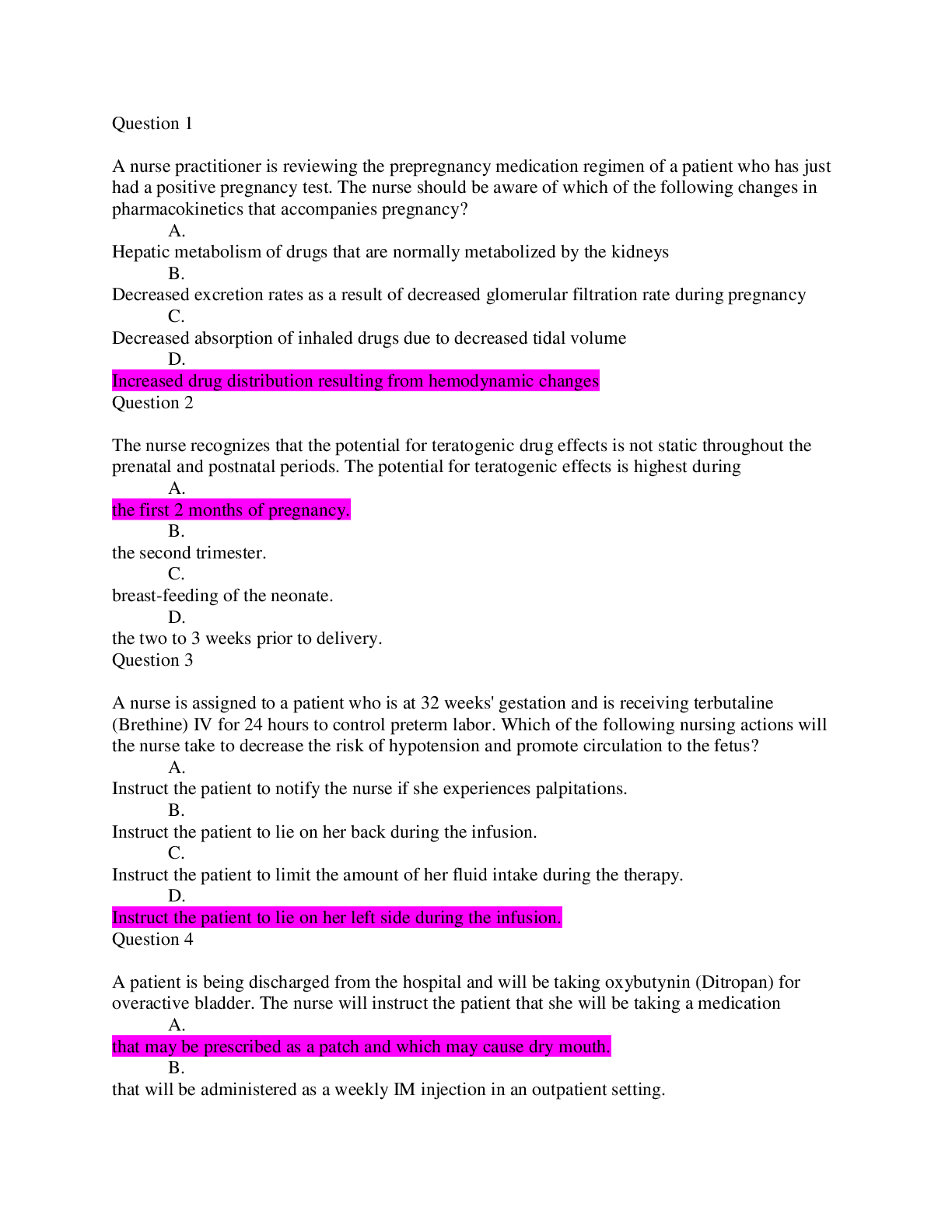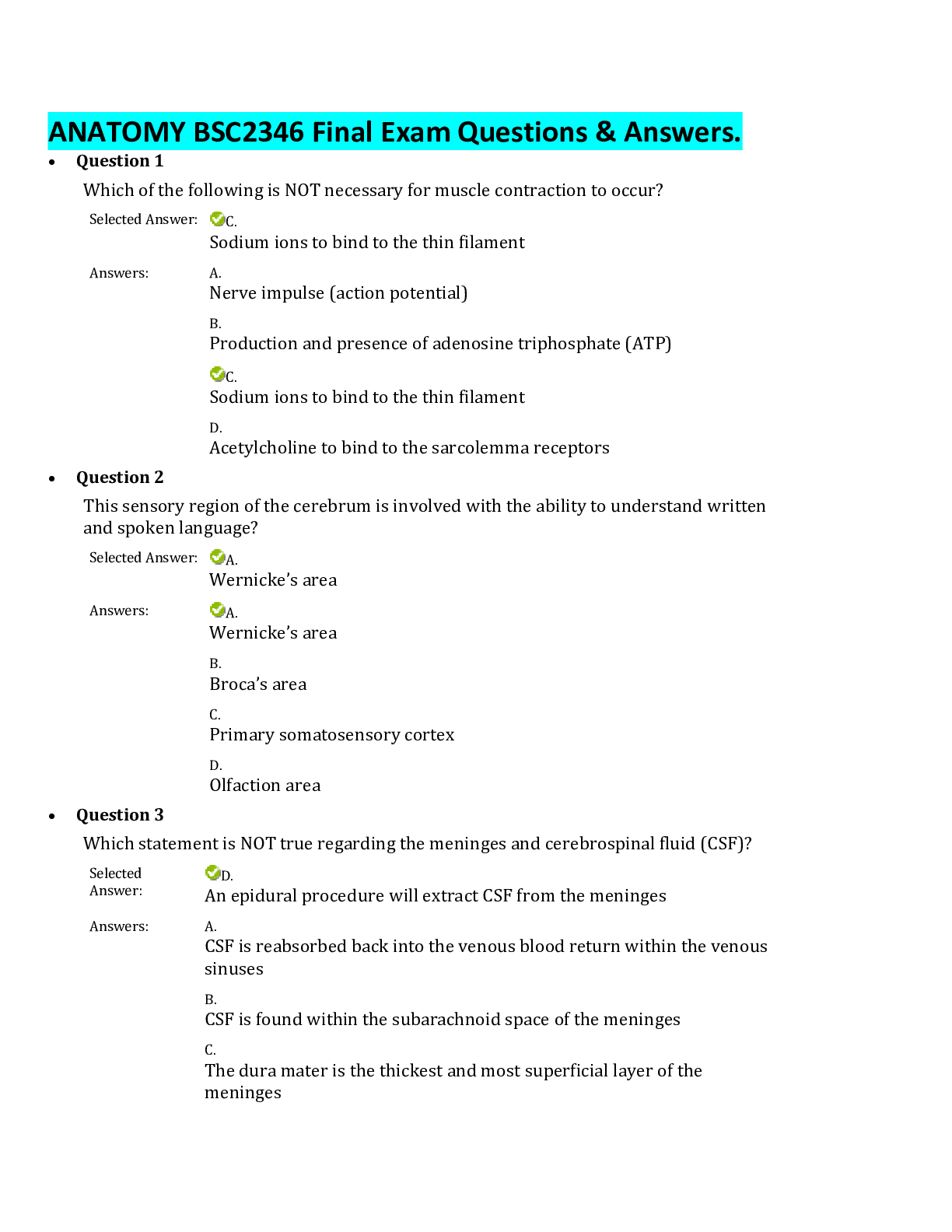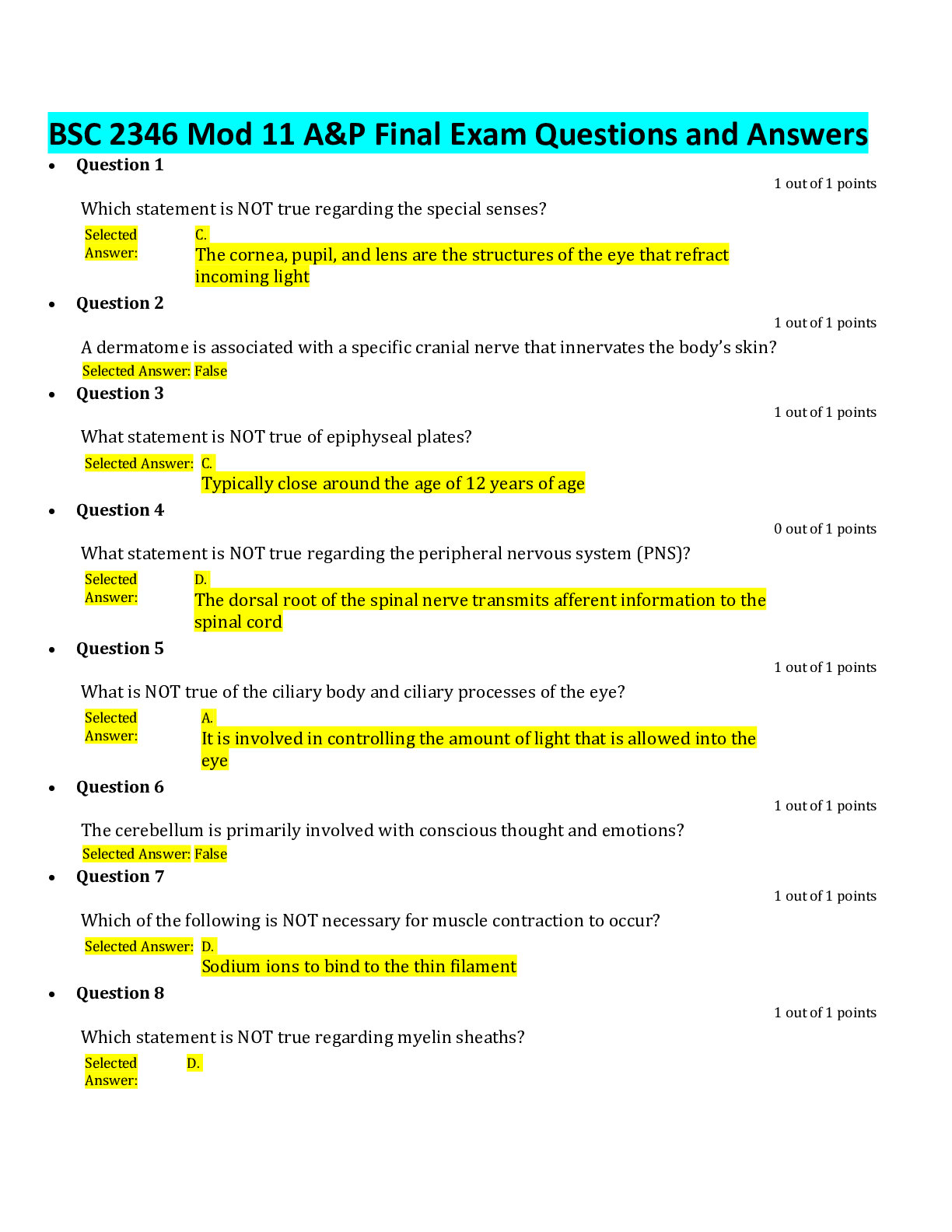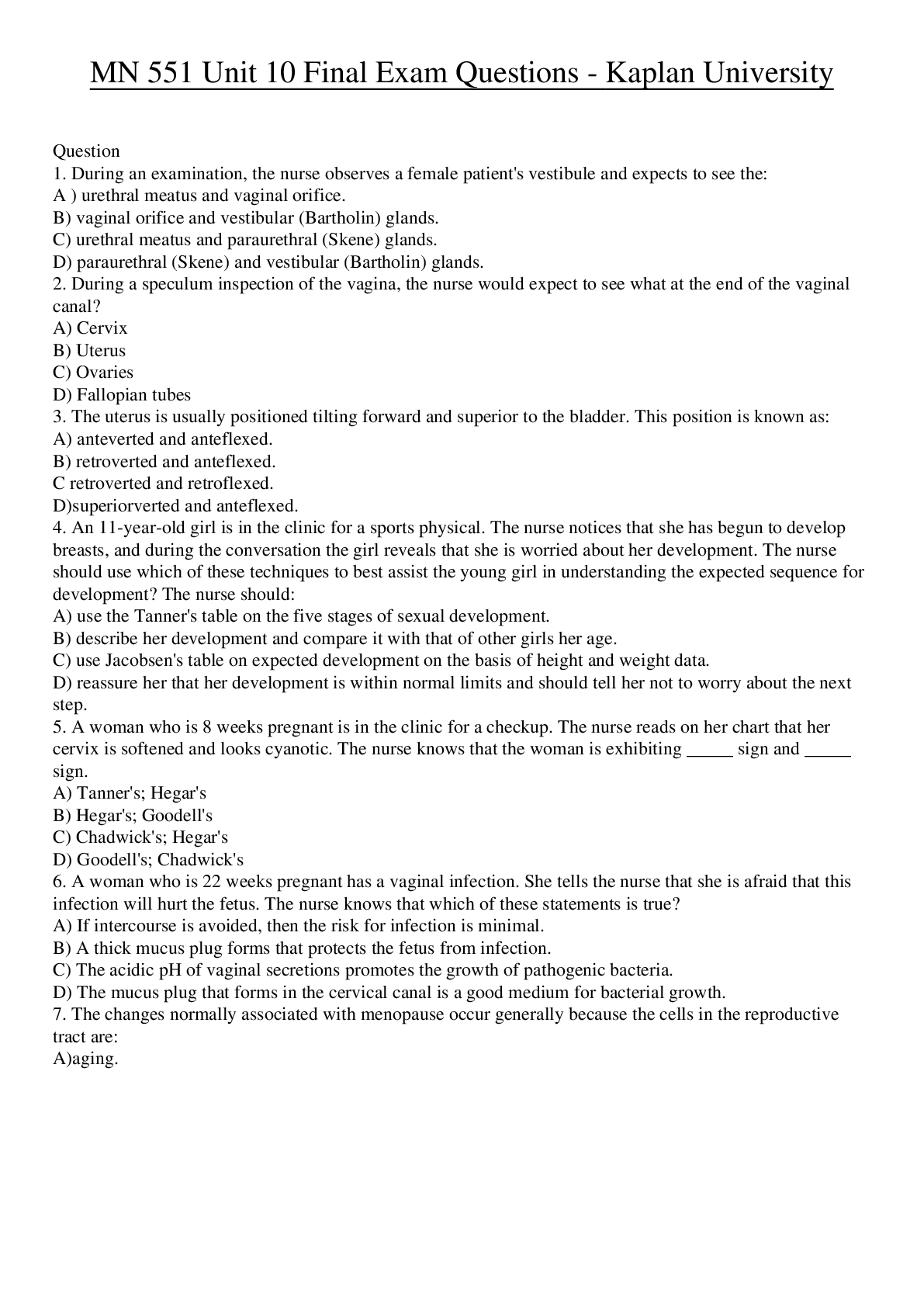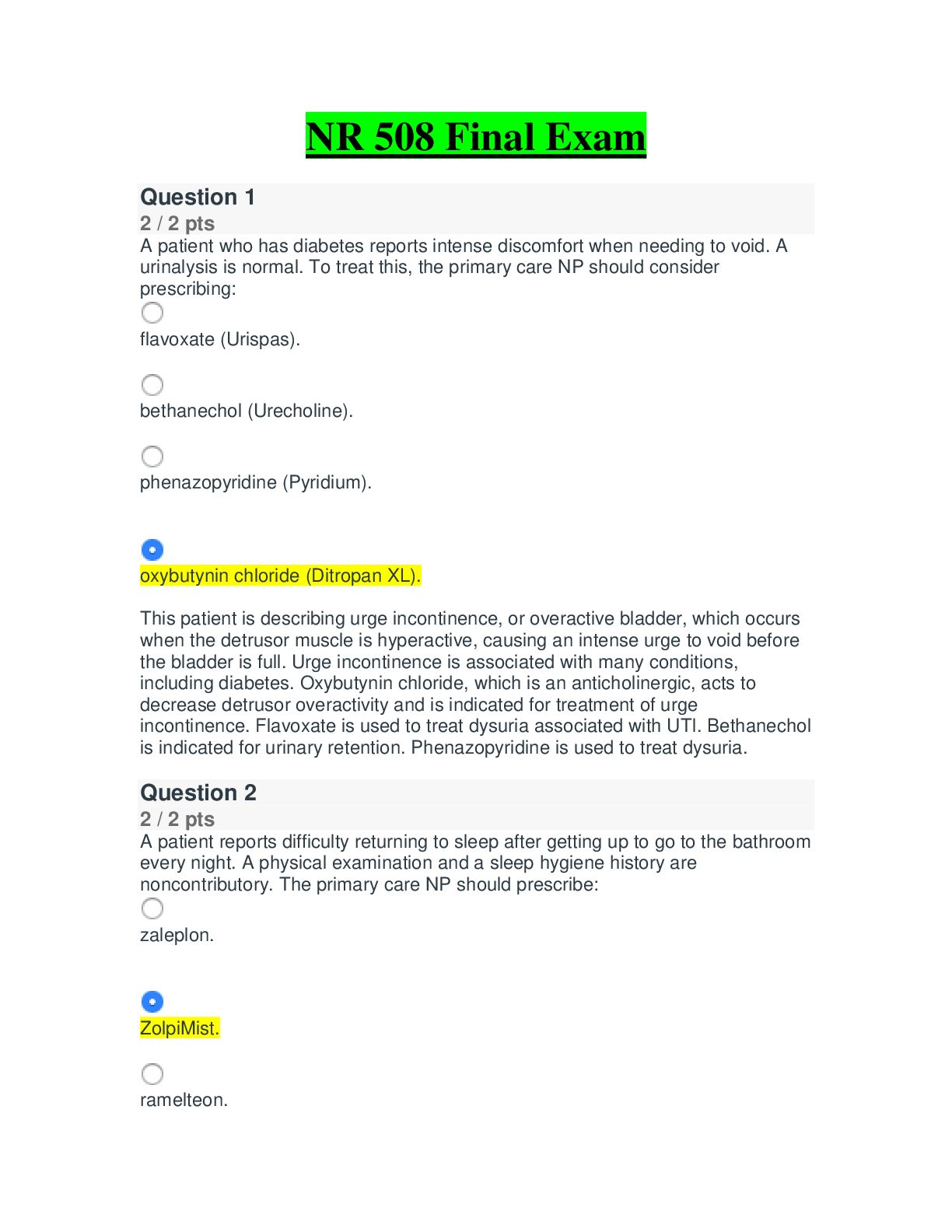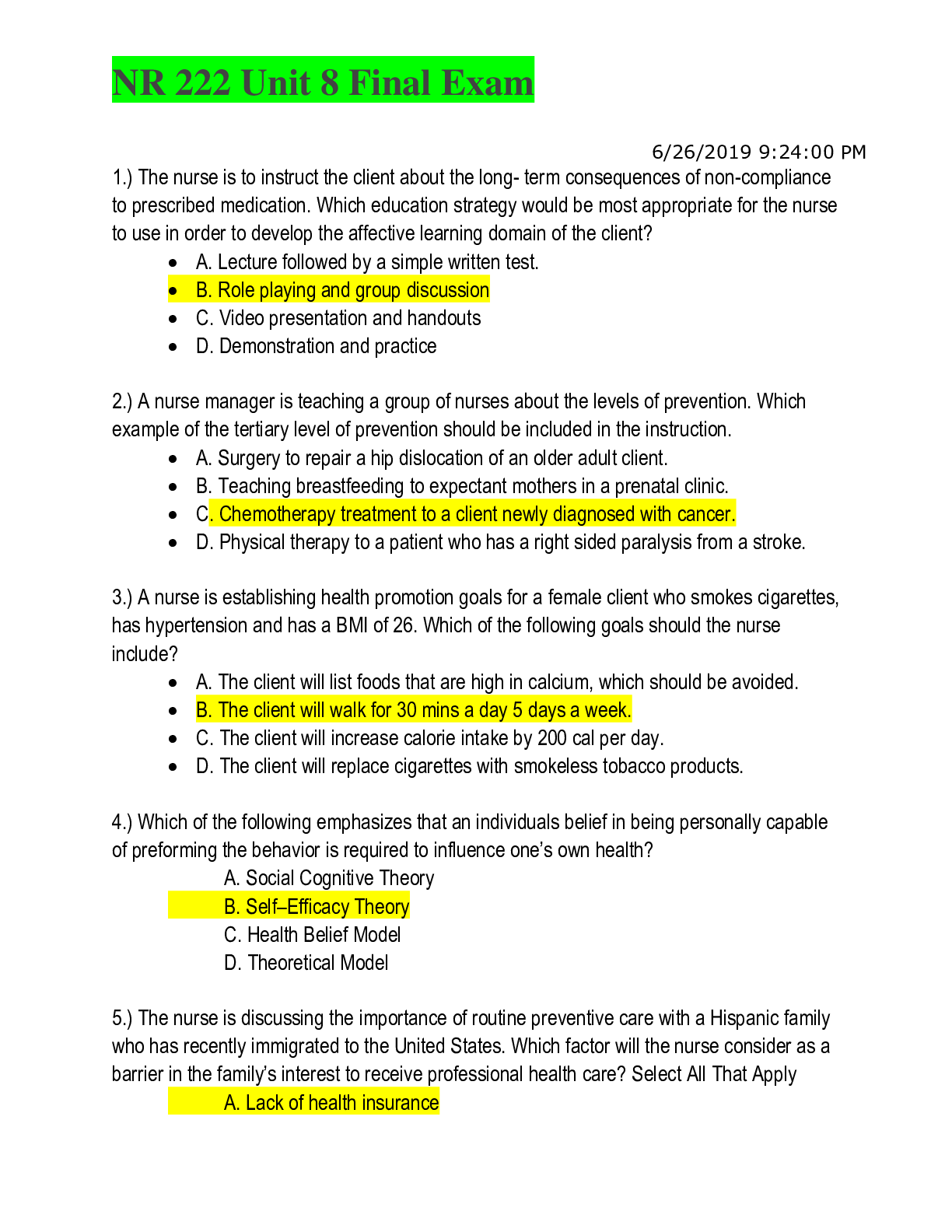Health Care > EXAM > NURS 6531 Final Exam Questions and Answers (All)
NURS 6531 Final Exam Questions and Answers
Document Content and Description Below
Question 2 In the outpatient office setting, the most common reason for a malpractice suit is failure to: Properly refer Diagnose correctly in a timely fashion Obtain informed consent Manage fra... ctures and trauma correctly Question 3 Reed-Sternberg B lymphocytes are associated with which of the following disorders: Aplastic anemia Hodgkin’s lymphoma Non Hodgkin’s lymphoma Myelodysplastic syndromes Question 4 The initial clinical sign of Dupuytren’s contracture is: Pain with ulnar deviation Painless nodule on palmer fascia Pain and numbness in the ring finger Inability to passively extend NURS 6531 Final Exam Questions and Answers finger Question 5 Marsha presents with symptoms resembling both fibromyalgia and chronic fatigue syndrome, which have many similarities. Which of the following is more characteristic of fibromyalgia? Musculoskeletal pain Difficulty sleeping Depression Fatigue Question 6 A child with type 1 diabetes mellitus has experienced excessive hunger, weight gain and increasing hyperglycemia. The Somogyi effect is suspected. What steps should be taken to diagnose and treat this condition? Decrease the evening insulin dose and check capillary blood glucose (CBG) at 2:00 am. Instruct the child’s parents on physical activities to help weight loss. Increase the evening insulin dose and check CBG at 2:00 am. Refer the child for instruction on a strict diabetic diet. Question 7 The 4 classic features of Parkinson’s disease are: Mask-like facies, dysarthria, excessive salivation, and dementia. Tremor at rest, rigidity, bradykinesia, and postural disturbances. Depression, cognitive impairment, constipation and shuffling gait. Tremor with movement, cogwheeling, repetitive movement, and multi- system atrophy. Question 8 What conditions must be met for you to bill “incident to” the physician, receiving 100% reimbursement from Medicare? You must initiate the plan of care for the patient The physician must be on-site and engaged in patient care You must be employed as an independent contractor You must be the main health care provider who sees the patient Question 9 The cornerstone of treatment for stress fracture of the femur or metatarsal stress fracture is: Rest from activities which may further stress the bone. Daily passive range of motion exercises. Continuation of the patient’s routine physical activities. Application of ice after activity. Question 10 Which of the following antibiotics should not be prescribed for a pregnant woman in the 3rd trimester? Trimethoprimsulfamethoxazole Erythromycin Cefuroxime Levofloxacin Question 11 Which is the most common cause of end-stage renal disease in the United States? Diabetic nephropathy Chronic renal failure secondary to vascular disorders Acute tubular necrosis Kidney trauma Question 12 A typical description of a tension headache is: Periorbital pain, sudden onset, often explosive in quality, and associated with nasal stuffiness, lacrimation, red eye, and nausea. Bilateral, occipital, or frontal tightness or fullness, with waves of aching pain. Hemicranial pain that is accompanied by vomiting and photophobia. Steadily worsening pain that interrupts sleep, is exacerbated by orthostatic changes, and may be preceded by nausea and vomiting. Question 13 A patient taking levothyroxine is being over-replaced. What condition is he at risk for? Osteoporo sis Constipati on Depression Exopthalmi a Question 14 Which of the following medications increase the risk for metabolic syndrome? Antihistamines Proton pump inhibitors Protease inhibitors A and C All of the above Question 15 You are assessing a patient after a sports injury to his right knee. You elicit a positive anterior/posterior drawer sign. This test indicates an injury to the: Lateral meniscus Cruciate ligament Medical meniscus Collateral ligament Question 16 A middle-aged man presents to urgent care complaining of pain of the medial condyle of the lower humerus. The man works as a carpenter and describes a gradual onset of pain. On exam, the medial epicondyle is tender and pain is increased with flexion and pronation. Range of motion is full The most likely cause of this patient’s pain is: Gout Epicondyliti s Osteoarthri tis Lyme disease Question 17 The organism most often associated with prostatitis is: Klebsiella Neiserria gonorrhoaes Chlamydia trachomatis E.Coli Question 18 Dave, age 38, states that he thinks he has an ear infection because he just flew back from a business trip and feels unusual pressure in his ear. You diagnose barotrauma. What is your next action? Prescribe systemic antibiotics Prescribe antibiotic ear drops Prescribe nasal steroids and oral decongestants Refer him to an ear, nose, and throat specialist Question 19 Maria, age 17, was raped when she was 13 year old. She is now experiencing sleeping problems, flashbacks, and depression. What is your initial diagnosis? Depression Panic disorder Anxiety Post-traumatic stress disorder Question 20 What diabetic complications result from hyperglycemia? 1. 1. 1. Retinopathy 2. Hypertension resistant to treatment 3. Peripheral neuropathy 4. Accelerated atherogenesis 1, 2, 3 2, 3, 4 1, 3, 4 1, 2, 4 Question 21 Prolonged PT suggests: Platelet abnormality Abnormality in intrinsic coagulation pathway Abnormality in extrinsic coagulation pathway None of the above Question 22 The most reliable indicator(s) of neurological deficit when assessing a patient with acute low back pain is(are): Patient report of bladder dysfunction, saddle anesthesia, and motor weakness of limbs. History of significant trauma relative to the patient’s age. Decreased reflexes, strength, and sensation in the lower extremities. Patient report of pain with the crossed straight leg raise. Question 23 A patient presenting for an annual physical exam has a BMI of 25 kg/m2 This patient would be classified as: Underweigh t Normal weight Overweight Obese Question 24 Jennifer says that she has heard that caffeine can cause osteoporosis and asks you why. How do you respond? “Caffeine has not effect on osteoporosis.” “A high caffeine intake has a diuretic effect that may cause calcium to be excreted more rapidly.” “Caffeine affects bone metabolism by altering intestinal absorption of calcium and assimilation of calcium into the bone matrix.” “Caffeine increase bone resorption.” Question 25 Jack, age 55, comes to the office with a blood pressure of 144/98 mm Hg. He states that he did not know if it was ever elevated before. When you retake his blood pressure at the end of the exam, it remains at 144/98. What should your next action be? Start him on an ACE Inhibitor Start him on a diuretic Have him monitor his blood pressure at home Try nonpharmacological methods and have him monitor his blood pressure at home Question 26 Diagnostic radiological studies are indicated for low back pain: Routinely after 3 weeks of low back pain symptoms. To screen for spondylolithiasis in patients less than 20 years of age with 2 weeks of more of low back pain. When there is a suspicion of a space-occupying lesion, fracture, cauda equina, or infection. As a part of a pre-employment physical when heavy lifting is included in the job description. Question 27 Risk factors for Addison’s disease include which of the following? Tuberculosis Autoimmune disease AIDS All of the above Question 28 A 32 year old female patient presents with fever, chills, right flank pain, right costovertebral angle tenderness, and hematuria. Her urinalysis is positive for leukocytes and red blood cells. The nurse practitioner diagnoses pyelonephritis. The most appropriate management is: Consult with a physician A 14 day course of ciprofloxacin To obtain blood cultures from separate site Obtain urine cultures, CBC, and initiate antibiotic therapy Question 29 A patient has just been diagnosed with Bell’s palsy. He is understandably upset and has questions about the prognosis. You response should be: Although most of your symptoms will disappear, some will remain but can usually be camouflaged by altering your hairstyle or growing a beard Unfortunately there is no cure but you have a mild case The condition is self-limiting and most likely complete recovery will occur With suppressive drug therapy you can minimize the symptoms Question 30 After treating a patient for Helicobacter pylori infection, what test do you order to see if it has been cured? An enzyme-linked immunosorbent assay titer A urea breath test A rapid urease test A repeat endoscopy Question 31 A patient presents with dehydration, hypotension, and fever. Laboratory testing reveals hyponatremia, hyperkalemia, and hypoglycemia. These imbalances are corrected, but the patient returns 6 weeks later with the same symptoms of hyperpigmentation, weakness, anorexia, fatigue, and weight loss. What action(s) should the nurse practitioner take? Obtain a thorough history and physical, and check serum cortisol and ACTH levels. Obtain a diet history and check CBC and FBS. Provide nutritional guidance and have the patient return in 1 month. Consult home health for intravenous administration of fluids and electrolytes. Question 32 The most common symptoms of transient ischemic attack (TIA) include: Nausea, vomiting, syncope, incontinence, dizziness, and seizure. Weakness in an extremity, abruptly slurred speech, or partial loss of vision, and sudden gait changes. Headache and visual symptoms such as bright spots or sparkles crossing the visual field. Gradual onset of ataxia, vertigo, generalized weakness, or lightheadedness Question 33 Which patient would benefit most from screening for type 2 diabetes? A 30 year old female with unintended weight loss. A 25 year old male with family history of type 1 diabetes An obese female with recurrent vaginitis A 50 year old hyperlipidemic male Question 34 An obese hyperlipidemic patient, newly diagnosed with type 2 diabetes mellitus, has fasting glucose values 180 to 250 mg/Dl. What is the most appropriate initial treatment to consider? A low-calorie diet and exercise Sliding-scale NPH insulin every 12 hours An oral hypoglycemic agent Sliding-scale regular insulin every 6 hours Question 35 A 32 year old male patient complains of urinary frequency and burning on urination for 3 days. Urinalysis reveals bacteriuria. He denies any past history of urinary tract infection. The initial treatment should be: Trimethoprim-sulfamethoxazole for 3 days Ciprofloxacin for 7-10 days Trimethoprim-sulfamethoxazole for 14 days Ciprofloxacin for 3 days Question 36 The most reliable diagnostic indicator of gout is: Monosodium urate (MSU) crystals in the synovial fluid. Tophi visible over joints or in connective tissue. Elevated serum uric acid level. Abrupt onset of single joint inflammation and pain. Question 37 A 60 year old male patient with multiple health problems presents with a complaint of erectile dysfunction (ED). Of the following, which medication is most likely to be causing the problem? Thiazide diuretic Insulin Famotidine (Pepcid) Albuterol Question 38 Diabetes screening recommendations for asymptomatic adults age 45 and over include which of the following: HbA1C 2-hour 75 gram oral glucose tolerance test C-peptide level A and B All of the above Question 39 Diagnostic evaluation of hypothyroidism reveals: Elevated TSH and decreased T4 Decreased TSH and increased T4 Decreased TSH and decreased T3 Elevated TSH and increased T4 Question 40 The most effective intervention(s) to prevent stroke is (are): 81 mg of aspirin daily Carotid endarterectomy for patients with high-grade carotid lesions Routine screening for carotid artery stenosis with auscultation for bruits Smoking cessation and treatment of hypertension Question 41 Josh, age 22, is a stock boy and has an acute episode of low back pain. You order and NSAID and tell him which of the following? Maintain moderate bed rest for 3-4 days Call the office for narcotics if there is no relief with the NSAID in 24-48 hours Begin lower back strengthening exercises depending on pain tolerance Wear a Boston brace at night Question 42 The cardinal sign of infectious arthritis is: Affected joint is painful at rest, with movement and weight bearing Rapid onset that wakes the patient during the night Long history of severe pain with associated joint swelling [Show More]
Last updated: 1 year ago
Preview 1 out of 37 pages
Instant download

Buy this document to get the full access instantly
Instant Download Access after purchase
Add to cartInstant download
Reviews( 0 )
Document information
Connected school, study & course
About the document
Uploaded On
Aug 10, 2022
Number of pages
37
Written in
Additional information
This document has been written for:
Uploaded
Aug 10, 2022
Downloads
0
Views
67

